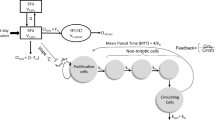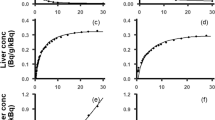Abstract
What can be inferred from limited clinical data by using current models of hepatic elimination? We examined this question by analyzing previously published data on the steady-state uptake of the anticancer agent 5-fluorouracil (5-FU) in seven cancer patients in terms of the venous equilibration model, the undistributed and distributed forms of the sinusoidal perfusion model, and the convection-dispersion model. Because of appreciable extrasplanchnic removal of 5-FU, the value of the steady infusion rate was not used in our analysis. When the data from all patients were pooled by plotting the measured hepatic venous concentration against the measured hepatic arterial concentration, the high concentration data fell on a limiting straight line of slope 1, indicating that at high dose rates elimination of 5-FU in both the liver and gastrointestinal tract was close to saturation. The intercept of this line gave a model-independent estimate of Vmax/Q= 48.0±11.6 (SD) μM for the pooled data set, where Vmax is the maximum splanchnic elimination rate of 5-FU, and Q is the hepatic blood flow. The low concentration data points fell on a limiting straight line through the origin, from which model-dependent values of the Michaelis constant were determined. The venous equilibration model gave K m=9.4μM,while the undistributed sinusoidal perfusion model gave K *m =26,5μM. With these values of K m,both models fit the pooled data equally well. These methods were applied to analyses of the five individual data sets which contained sufficiently high concentration data points. The resulting mean values were Vmax/Q=41.0±5.1 (sem) μM,K m=8.4±1.3μM and K *m =23.2±3.2 μM. However, the splanchnic region is a highly heterogeneous organ system, for which an undistributed analysis provides no more than an upper bound on the Michaelis constant K +m (K +m ⩽K *m ).A perfusion model distributed to represent total splanchnic elimination is developed in the Appendix. Using previous estimates of the degree of functional heterogeneity in the liver alone, this model yields K +m values for individual patients which have a mean of 20.3±2.8 μM.
Similar content being viewed by others
References
J. L. Speyer, P. H. Sugarbaker, J. M. Collins, R. L. Dedrick, R. W. Klecker, Jr., and C. E. Myers. Portal levels and hepatic clearance of 5-fluorouracil after intraperitoneal administration in humans.Cancer Res. 41:1916–1922 (1981).
M. Chadwick and J. Rogers. The physiological disposition of 5-fluorouracil in mice bearing solid L1210 lymphocytic leukemia.Cancer Res. 32:1045–1056 (1972).
B. G. Gustavsson, A. Brandberg, C. G. Regardh, and O. E. Almersjo. Regional and systemic serum concentration of 5-fluorouracil after portal and intravenous infusion: an experimental study in dogs.J. Pharmacokin. Biopharm. 7:665–673 (1979).
Y.-H. Kao, C.-Y. Yang, R. R. L. Chen, and J.-D. Huang. Pulmonary elimination of 5-fluorouracil in anesthetized rats.J. Pharm. Sci. 74:1095–1096 (1985).
J. G. Wagner, J. W. Gyves, P. L. Stetson, S. C. Walker-Andrews, I. S. Wollner, M. K. Cochran, and W. P. Ensminger. Steady-state nonlinear pharmacokinetics of 5-fluorouracil during hepatic arterial and intravenous infusions in cancer patients.Cancer Res. 46:1499–1506 (1986).
L. Bass, S. Keiding, K. Winkler, and N. Tygstrup. Enzymatic elimination of substrates flowing through the intact liver.J. Theor. Biol. 61:393–409 (1976).
J. R. Gillette. Factors affecting drug metabolism.Ann. N.Y. Acad. Sci. 179:43–66 (1971).
M. Rowland, L. Z. Benet, and G. G. Graham. Clearance concepts in pharmacokinetics.J. Pharmacokin. Biopharm. 20:123–136 (1973).
R. A. Branch, A. S. Nies, and D. G. Shand. The disposition of propranolol VIII. General implications of the effects of liver blood flow on elimination from the perfused rat liver.Drug Metab. Dispos. 1:687–690 (1973).
L. Bass, P. J. Robinson, and A. J. Bracken. Hepatic elimination of flowing substrates: The distributed model.J. Theor. Biol. 72:161–184 (1978).
M. S. Roberts and M. Rowland. Hepatic elimination—dispersion model.J. Pharm. Sci. 74:585–587 (1985).
M. S. Roberts and M. Rowland. A dispersion model of hepatic elimination.J. Pharmacokin. Biopharm. 14:227–308 (1986).
L. Bass, M. S. Roberts, and P. J. Robinson. On the relation between extended forms of the sinusoidal perfusion and of the convection-dispersion models of hepatic elimination.J. Theor. Biol 126:457–482 (1987).
R. W. Brauer, G. F. Leong, R. F. McElroy, and R. J. Holloway. Circulatory pathways in the rat liver as revealed by P32 chromic phosphate colloid uptake in the isolated perfused liver preparation.Am. J. Physiol. 184:593–598 (1956).
L. Bass. Flow-dependence of first-order uptake of substances by heterogeneous perfused organs.J. Theor. Biol. 86:365–376 (1980).
K. S. Pang and M. Rowland. Hepatic clearance of drugs. II. Experimental evidences for acceptance of the “well stirred” model over the “parallel tube” model using lidocaine in the perfused rat liver insitu preparation.J. Pharmacokin. Biopharm. 5:655–680 (1977).
S. Keiding and E. Chiarantini. Effect of sinusoidal perfusion on galactose elimination kinetics in perfused rat liver.J. Pharmacol. Exp. Ther. 205:465–470 (1978).
S. Keiding and E. Steiness. Flow dependence of propranolol elimination in perfused rat liver.J. Pharmacol. Exp. Ther. 230:474–477 (1984).
L. Bass. Saturation kinetics in hepatic drug removal: a statistical approach to functional heterogeneity.Am. J. Physiol. 244:G583-G589 (1983).
L. Bass and P. J. Robinson. Effects of capillary heterogeneity on rates of steady uptake of substances by the intact liver.Microvasc. Res. 22:43–57 (1981).
F. Mentre, J. L. Steimer, J. P. Sommadossi, R. B. Diasio, and J. P. Cano. A mathematical model of the kinetics of 5-fluorouracil and its catabolites in freshly isolated rat hepatocytes.Biochem. Pharmacol. 33:2727–2732 (1984).
J. M. Pries, A. B. Staples, and R. F. Hanson. Effect of hepatic blood flow on taurocholate extraction by the isolated perfused rat liver.J. Lab. Clin. Med. 97:412–417 (1981).
L. Bass and P. J. Robinson. How small is the functional variability of liver sinusoids?J. Theor. Biol. 81:761–769 (1979).
S. Keiding, S. Johansen, K. Winkler, K. Tonnesen, and N. Tygstrup. Michaelis-Menten kinetics of galactose elimination by the isolated pig liver.Am. J. Physiol. 230:1302–1313 (1976).
P. J. Robinson. Aspects of mathematical liver kinetics: the steady-state statistical mechanics of hepatic elimination. Ph.D. thesis, University of Queensland. (University Microfilms International, Ann Arbor, Michigan, 1979)
Author information
Authors and Affiliations
Additional information
We are grateful to the Australian Research Grants Scheme and the National Health and Medical Research Council for financial support, and to the Department of Science for the award of a National Research Fellowship to P.J.R.
Rights and permissions
About this article
Cite this article
Robinson, P.J., Bass, L., Pond, S.M. et al. Clinical applicability of current pharmacokinetic models: Splanchnic elimination of 5-fluorouracil in cancer patients. Journal of Pharmacokinetics and Biopharmaceutics 16, 229–249 (1988). https://doi.org/10.1007/BF01062135
Received:
Revised:
Published:
Issue Date:
DOI: https://doi.org/10.1007/BF01062135




